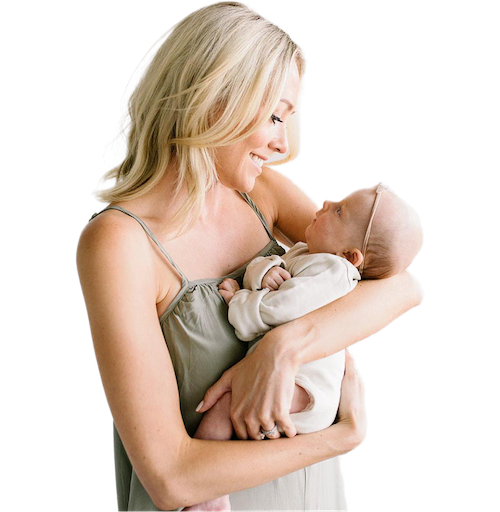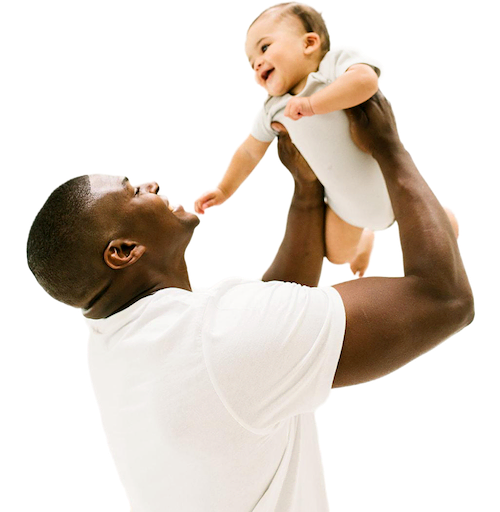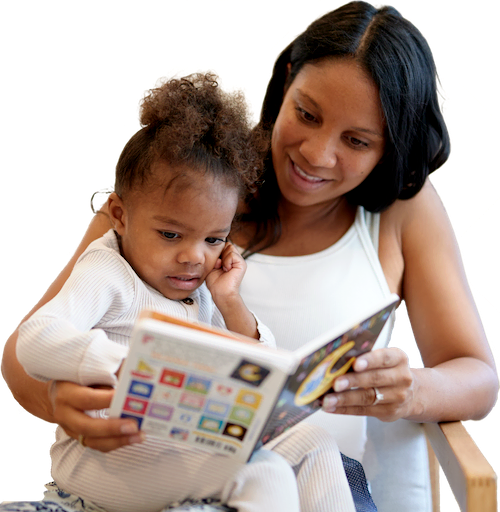The information on room sharing - when a baby sleeps in the same room as their parent(s) - can be overwhelming. I’d love to help. Let’s talk about room sharing with your baby, the American Academy of Pediatrics' (AAP) stance on room sharing, if newborns can sleep in their own room from birth, and when you should move your baby to their own room.
Spoiler: There’s no perfect time to move a baby to their own room. That decision is unique to every baby, and I’m here to walk you through how to make the best decision for your family. If you need extra support, my classes will help you have a great little sleeper no matter which room your baby uses for sleep.
When should my baby sleep in their own room? anchor
There is no exact age for when your baby should sleep in their own room. I do encourage room sharing in the first several months of life. However, this choice depends on what works best for each baby and family. Here are a few things to consider when deciding if it’s time for your baby to sleep in their own room:
Is their room set up with a safe sleeping space? We want your baby to have their own sleeping surface that meets all of the safe sleep requirements.
Have they outgrown their bassinet? If your little one is sitting independently, is beginning to push up to their hands and knees, or has met the height/weight limits set by the manufacturer, it’s time to make the transition to a crib.
Is room sharing causing major sleep interruptions? In a study from the American Academy of Pediatrics (AAP) on room sharing(1), pediatric experts point out that, for babies “inadequate sleep affects nearly every health domain, including emotional regulation, mood, and behavior in infancy and childhood.” This means that interrupted sleep in infancy should be a major factor in choosing where our babies sleep.
Are you ready? Weigh the risks and benefits and trust your inner voice. Yes, you know that voice. The one that says, “I know what’s best for my baby and our family."
I want you to take in all the facts, look at the research, talk with your doctor, use safe sleep guidelines, and make the best decision for you and your family regarding how long to room share.
What does the AAP say about room sharing? anchor
The American Academy of Pediatrics (AAP) recommends sharing a room with your baby for at least the first 6 months of their life to reduce the risk of SIDS.(2)
However, the AAP also published research that found that after 4 months, room sharing results in less nighttime sleep and more night wakings for infants.(1) The study also found that after 4 months, room sharing resulted in an increase in unsafe sleep practices.(1)
Safety Note: Keep in mind that room sharing and bed sharing are not the same things. Room sharing is when your baby has their own separate sleeping space (bassinet, crib, or play yard) in the same room as their parent(s). On the other hand, bed sharing is when a baby shares a sleeping space with another person. The AAP states that you should never sleep with your baby and always place them in their own safe sleeping space.(2)
Are there any concerns for room sharing beyond the first few months?anchor
For some families, room sharing works beautifully. For others, continuing to room share can actually cause problems.
What are those problems? To begin with, parents who are sleep deprived are more likely to practice unsafe sleep. Please know, I am all too familiar with pulling my baby into my bed in a sleep deprived moment of desperation. (I would love to share my personal story with you.)
Research shows that babies who room-share beyond 4 months of age were four times more likely to be pulled into their parents’ bed during the night, and two times more likely to have pillows, blankets, and other unsafe sleeping materials close by during sleep.(1) Pulling a baby into bed and sleeping with loose bedding is known to increase the risk of SIDS. So, keeping a baby in the same room beyond 4-6 months actually increased parental behaviors that are known to cause SIDS.
Safe sleep is about more than just SIDS. Sometimes, continuing to room share contributes to sleep deprivation, which creates a different set of risks for the whole family. What are those risks? Poor bonding with baby, marital struggles, Postpartum Depression(3) (this is true for both moms and dads(4)), anxiety, car accidents, and even Shaken Baby Syndrome. Sometimes, we don’t consider how truly dangerous sleep deprivation is. Research(5) shows that sleep deprivation affects us both cognitively and physically. Did you know our brains actually act drunk when we are sleep deprived?(6) It’s true!
So, what does this mean? Deciding when to move your baby into their own room requires a full-picture approach. You have to determine what is safest for your baby and your family based on the research AND what is happening during the night.
If it feels like --no matter where your baby sleeps-- you are all waking up exhausted, I can help. My classes are designed to meet your baby right where they are developmentally and get all of you the sleep that you need.
How does room sharing reduce SIDS?anchor
The AAP says that room sharing may reduce the risk of SIDS by as much as 50% in the first 3 months.(2) However, for older babies, the research is far more complicated.(1)
Here are things that we DO know can reduce the risk of SIDS(7):
Place your baby on their back on a firm, flat sleep surface with a tight-fitting sheet.
Only use products labeled "crib," "bassinet," "portable crib," or "play yard" for sleep.
Avoid the use of soft bedding, including crib bumpers, blankets, pillows, and soft toys. The crib should be bare.
Avoid exposing your baby to smoke, alcohol, and illicit drugs during pregnancy.
Consider breastfeeding (if it’s the right fit and choice for your family).
Offer a pacifier.
Prevent your baby from overheating by dressing them appropriately for sleep.
Does moving a baby to their own room help them sleep better? anchor
It’s possible, especially if your baby is 4 months or older. According to research, after 4 months, room sharing resulted in less nighttime sleep and more night wakings.(1)
Here's why: After about 4 months of age, babies are suddenly aware of the world around them. If your baby is sharing a room with you, seeing mom or dad (or even just knowing they are there) can cause night wakings. This can occur as often as every 45-120 minutes all night long.
So, yes! Sometimes transitioning your baby out of your room can actually help your baby sleep better at night.
Can you sleep train while room sharing?anchor
Yes, room sharing is acceptable for sleep training if that’s what feels like the best choice for your family. If you decide that sleep training is the right step for you, my 5–24 Month Collection is a plan to conquer nights, naps, and every bump along the way. You will be encouraged to give your baby their own space for the first 14 nights, but please know that we can customize this to your comfort.
How long does it take to transition a baby to their own room?anchor
For many babies who have been sleeping well in a bassinet, the transition to the crib is fairly seamless and takes just a few nights. Babies often adjust far better than we anticipate.
Please know that no matter when you are starting, I have classes designed to meet your baby right where they are developmentally. I will help show you how to have a great little sleeper no matter which room your baby uses for sleep.
5 tips for moving your baby to their own room anchor
1. Practice. Practice at least one nap a day in the nursery.
2. Daily routines. Go into the nursery multiple times a day- do diaper changes there, get your baby dressed, and play on the floor. This makes your baby’s room a familiar environment.
3. Bedtime routine. For 3-4 nights prior to transitioning to the nursery, do the bedtime routine in the nursery and then bring your baby into your room as usual. This sends the signal that the nursery is a safe place associated with snuggles and getting ready for sleep.
4. Move the bassinet. Try moving your baby’s bassinet into the nursery for a few nights. Keep all other conditions the same... bedtime routine, sound machine, dark and cool environment. Sometimes this mini transition before going into the crib can help your baby adjust to the new room.
5. Partial nights. After 3-5 nights, move your baby to the crib. If they awaken in the night, transition them to the bassinet in their own room. Each night try to get longer and longer stretches in the crib.
Are all of these steps really necessary? Nope! You know your baby best, so you’ll be the best one to decide what steps will work for your little one. For me personally, I did steps 1-3 fairly consistently and then just put them in the crib; the transition was simple. They never seemed to notice a change because it was a familiar routine and environment.
If moving to the nursery feels overwhelming or if sleep is already hard, my classes are here to help.
For newborns 4 months and younger, the First Five Months Bundle is a cry-free method for teaching foundational sleep skills to newborn babies. Let me help you work on establishing great sleep with your young baby, whether you’re ready for the transition to the nursery or not.
My 5–24 Month Collection will teach you everything you need to know to have a great little sleeper (no matter what room they sleep in at night) while remaining emotionally connected and present every step along the way.
References
7 Sources
Paul et al. (2017). Mother-Infant Room-Sharing and Sleep Outcomes in the INSIGHT Study
Healthy Children, American Academy of Pediatrics. (2023). How to Keep Your Sleeping Baby Safe: AAP Policy Explained
Martin et al. (2007). Adverse associations of infant and child sleep problems and parent health: an Australian population study
Cook et al. (2017). Depression and anger in fathers of unsettled infants: A community cohort study
Killgore. (2010). Effects of sleep deprivation on cognition
Williamson and Feyer. (2000). Moderate sleep deprivation produces impairments in cognitive and motor performance equivalent to legally prescribed levels of alcohol intoxication
CDC. (2022). Creating a Safe Sleep Area for Babies
Keep in mind that the information and content on this blog is for informational purposes and should not be considered medical advice. If you have questions about your child, please reach out to your doctor.












